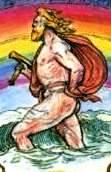
The Milky Way
Irung's Way and Irung's Wall
by Peter Krüger
©2013
[Germanic Astronomy]
"If ever on a clear night, when Night in the heavens shows to men all her stars in their brightness and no star is borne faintly gleaming at the mid-month moon, but they all sharply pierce the darkness— if in such an hour wonder rises in thy heart to mark on every side the heaven cleft by a broad belt, or if someone at the side point out that circle set with brilliants— that is what men call the Milky Way. A match for it in colour thou wilt find no circle wheel, but in size two of the four belts [zodiac, celestial equator] as large, but the other two [Tropic of Cancer, Tropic of Capricorn] are far inferior."

So too in Germanic sources we find many references to the Milky Way as summarized in an excerpt from Jacob Grimm's Teutonic Mythology, chapter 15:
It is normally described as a way or street, for example as
Wattlingestrete or Iringesstrâza (Widukind), Iringes uuec, Iuuåringes
uueg, Euringsstrass.
Interestingly in Þiðreks Saga af Bern (ch. 387) we find a different
story. There we find a description of Irung's final battle with Högni,
who causes him to fall against a stone wall, which is still called
Irûngs veggr in memory of the hero:
Ok þá lætr Írungr sigast við steinvegginn, ok þessi steinveggr heitir Írungsveggr enn í dag.
"Irung then sank against the stone wall and this wall is still called Irung's wall today." (Edward Haymes tr.)
"The Norse redactor confounded vegr (via, way) with veggr (murus, wall); his German source must have had Iringes vec, in allusion to the 'cutting his way' in Widukind."
Even though this conclusion sounds logical, I suggest that the Milky Way has indeed been known in Germanic sources both as a way and a wall. As described in my essay 'Asgard's wall - the Milky Way', there are good reasons to identify the wall of Asgard, erected by an unnamed mountain giant with the rising Milky Way starting from the area of Sagittarius to the rising of the Pleiades (identified as Mjöllnir) and Taurus (Thor).

